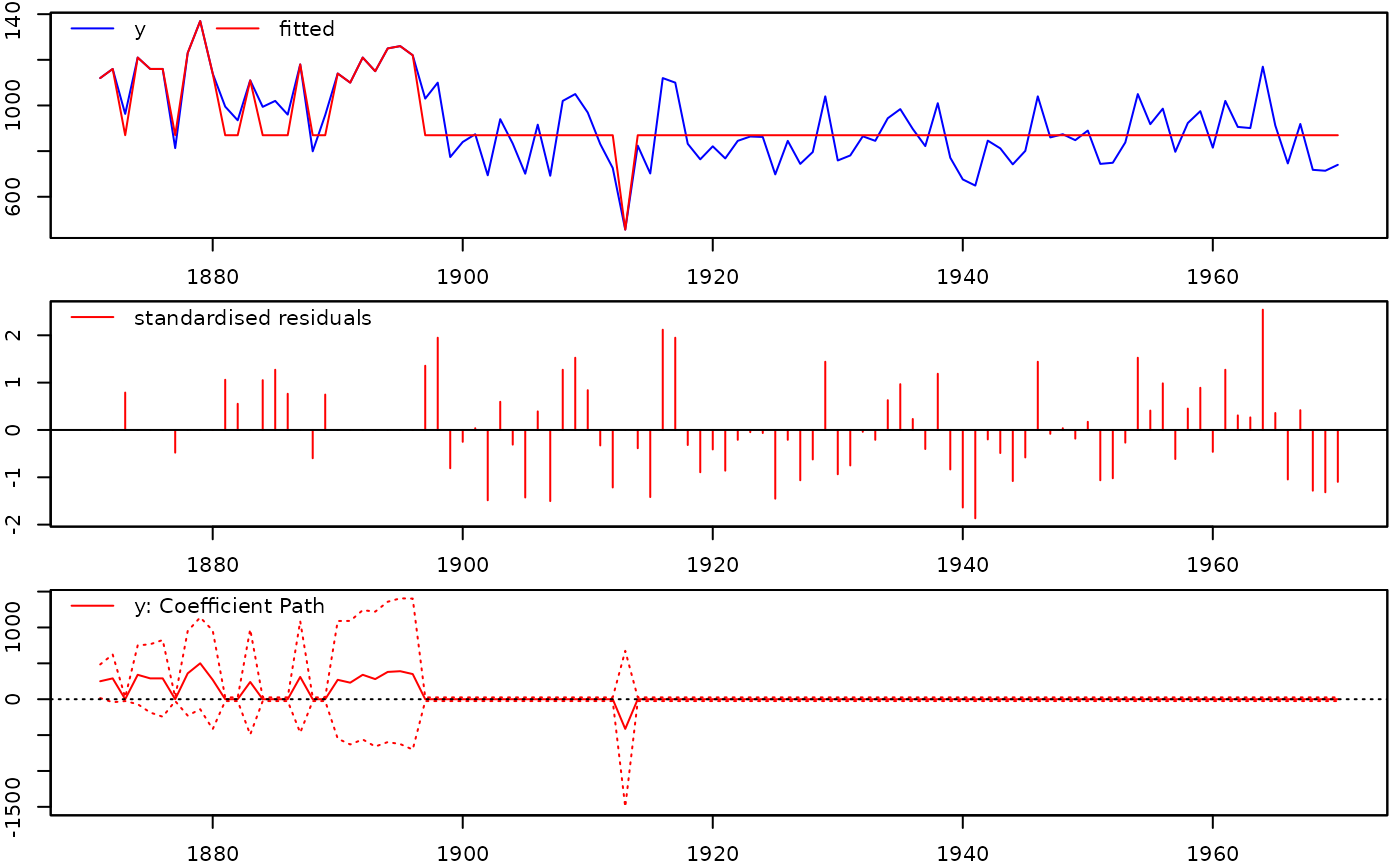Consistency and Efficiency Correction for Impulse Indicator Saturation
isatvarcorrect.RdTakes an isat object and corrects the estimates of the error variance and the estimated standard errors of 'forced' regressors.
Arguments
- x
an
isatobject- mcor
integer, number of iterations in the correction. Default = 1.
Details
Impulse indicator saturation results in an under-estimation of the error variance as well as the variance of regressors not selected over. The magnitude of the inconsistency increases with the p-value of selection (t.pval). The function takes an isat object and applies the impulse indicator consistency (isvarcor) and efficiency correction (isvareffcor) of the estimated error variance and the estimated variance of regressors not selected over. See Johansen and Nielsen (2016a) and (2016b).
Value
Returns an isat object in which the estimated standard errors, t-statistics, p-values, standard error of the regression, and log-likelihood are consistency and efficiency corrected when using impulse indicator saturation (iis=TRUE).
References
Johansen, S., & Nielsen, B. (2016a). Asymptotic theory of outlier detection algorithms for linear time series regression models. Scandinavian Journal of Statistics, 43(2), 321-348.
Johansen, S., & Nielsen, B. (2016b). Rejoinder: Asymptotic Theory of Outlier Detection Algorithms for Linear. Scandinavian Journal of Statistics, 43(2), 374-381.
Pretis, F., Reade, J., & Sucarrat, G. (2018). Automated General-to-Specific (GETS) regression modeling and indicator saturation methods for the detection of outliers and structural breaks. Journal of Statistical Software, 86(3).
Author
Felix Pretis, https://felixpretis.climateeconometrics.org/
Examples
###Consistency and Efficiency Correction of Impulse Indicator Estimates
nile <- as.zoo(Nile)
isat.nile <- isat(nile, sis=FALSE, iis=TRUE, plot=TRUE, t.pval=0.1)
#>
#> IIS block 1 of 4:
#> 9 path(s) to search
#> Searching:
#> 1
#> 2
#> 3
#> 4
#> 5
#> 6
#> 7
#> 8
#> 9
#>
#> IIS block 2 of 4:
#> 23 path(s) to search
#> Searching:
#> 1
#> 2
#> 3
#> 4
#> 5
#> 6
#> 7
#> 8
#> 9
#> 10
#> 11
#> 12
#> 13
#> 14
#> 15
#> 16
#> 17
#> 18
#> 19
#> 20
#> 21
#> 22
#> 23
#>
#> IIS block 3 of 4:
#> 24 path(s) to search
#> Searching:
#> 1
#> 2
#> 3
#> 4
#> 5
#> 6
#> 7
#> 8
#> 9
#> 10
#> 11
#> 12
#> 13
#> 14
#> 15
#> 16
#> 17
#> 18
#> 19
#> 20
#> 21
#> 22
#> 23
#> 24
#>
#> IIS block 4 of 4:
#> 25 path(s) to search
#> Searching:
#> 1
#> 2
#> 3
#> 4
#> 5
#> 6
#> 7
#> 8
#> 9
#> 10
#> 11
#> 12
#> 13
#> 14
#> 15
#> 16
#> 17
#> 18
#> 19
#> 20
#> 21
#> 22
#> 23
#> 24
#> 25
#>
#> GETS of union of retained IIS variables...
#>
#> GETS of union of ALL retained variables...
 isat.nile.corrected <- isatvarcorrect(isat.nile)
isat.nile$sigma2
#> [1] 13973.97
isat.nile.corrected$sigma2
#> [1] 22429.57
isat.nile.corrected <- isatvarcorrect(isat.nile)
isat.nile$sigma2
#> [1] 13973.97
isat.nile.corrected$sigma2
#> [1] 22429.57